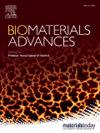具有成纤维细胞球体的仿生梯度水凝胶用于全层皮肤再生。
IF 5.5
2区 医学
Q2 MATERIALS SCIENCE, BIOMATERIALS
Materials Science & Engineering C-Materials for Biological Applications
Pub Date : 2024-12-16
DOI:10.1016/j.bioadv.2024.214152
引用次数: 0
摘要
水凝胶基支架在组织工程中加速组织再生的应用已被广泛研究。然而,用适当的生物线索复制组织的生理微环境仍然具有挑战性。梯度水凝胶的最新进展通过提供模拟自然组织细胞外基质的精确结构,改变了组织工程研究。与传统的均匀结构水凝胶不同,梯度水凝胶通过调节各种细胞行为,如增殖、迁移和分化,为慢性伤口治疗中的联合细胞治疗提供了更好的生物模拟微环境。在这里,我们将L929小鼠成纤维细胞球体整合到梯度水凝胶中以模拟皮肤硬度微环境,并研究了它们对全层皮肤再生的影响。采用双注射泵系统,通过调节甲基丙烯酸化透明质酸(HA-MA)不同甲基丙烯酸化程度的浓度,实现了硬度梯度。在大鼠模型中,梯度水凝胶包封L929球体促进皮肤细胞分层有序组织,导致全层创面愈合速度比未处理组快1.53倍。本研究为研究梯度水凝胶在各种组织工程和再生应用中的潜在作用提供了一种方法。本文章由计算机程序翻译,如有差异,请以英文原文为准。
Biomimetic gradient hydrogel with fibroblast spheroids for full-thickness skin regeneration
Hydrogel-based scaffolds have been widely investigated for their use in tissue engineering to accelerate tissue regeneration. However, replicating the physiological microenvironments of tissues with appropriate biological cues remains challenging. Recent advances in gradient hydrogels have transformed tissue-engineering research by providing precise structures that mimic the extracellular matrix of natural tissues. Unlike conventional homogeneously structured hydrogels, gradient hydrogels provide a better bio-mimicking microenvironment for combined cell therapies in chronic wound treatment by regulating various cell behaviors, such as proliferation, migration, and differentiation. Here, we present the integration of L929 mouse fibroblast spheroids into gradient hydrogels to mimic the dermal stiffness microenvironment and we investigated their impact on full-thickness skin regeneration. A stiffness gradient was achieved by modulating the concentration of methacrylated hyaluronic acid (HA-MA) with varying degrees of methacrylation, using a dual-syringe pump system. The encapsulation of L929 spheroids with gradient hydrogel facilitated skin cell organization in a hierarchically ordered configuration, leading to full-thickness wound healing that was 1.53 times faster than the untreated group in a rat model. This study provides a method for investigating the potential role of gradient hydrogels in various tissue engineering and regeneration applications.
求助全文
通过发布文献求助,成功后即可免费获取论文全文。
去求助
来源期刊
CiteScore
17.80
自引率
0.00%
发文量
501
审稿时长
27 days
期刊介绍:
Biomaterials Advances, previously known as Materials Science and Engineering: C-Materials for Biological Applications (P-ISSN: 0928-4931, E-ISSN: 1873-0191). Includes topics at the interface of the biomedical sciences and materials engineering. These topics include:
• Bioinspired and biomimetic materials for medical applications
• Materials of biological origin for medical applications
• Materials for "active" medical applications
• Self-assembling and self-healing materials for medical applications
• "Smart" (i.e., stimulus-response) materials for medical applications
• Ceramic, metallic, polymeric, and composite materials for medical applications
• Materials for in vivo sensing
• Materials for in vivo imaging
• Materials for delivery of pharmacologic agents and vaccines
• Novel approaches for characterizing and modeling materials for medical applications
Manuscripts on biological topics without a materials science component, or manuscripts on materials science without biological applications, will not be considered for publication in Materials Science and Engineering C. New submissions are first assessed for language, scope and originality (plagiarism check) and can be desk rejected before review if they need English language improvements, are out of scope or present excessive duplication with published sources.
Biomaterials Advances sits within Elsevier''s biomaterials science portfolio alongside Biomaterials, Materials Today Bio and Biomaterials and Biosystems. As part of the broader Materials Today family, Biomaterials Advances offers authors rigorous peer review, rapid decisions, and high visibility. We look forward to receiving your submissions!

 求助内容:
求助内容: 应助结果提醒方式:
应助结果提醒方式:


